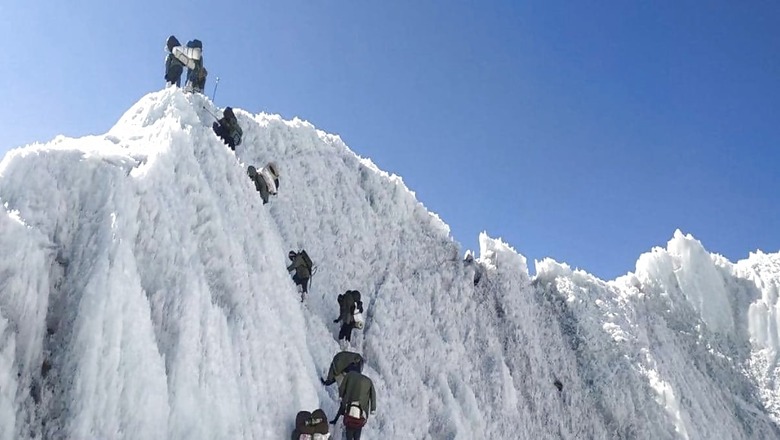
views
In view of the recent and deadly avalanche that struck a part of Sikkim and snatched seven irreplaceable lives, I would like to make the national and international citizenry aware, besides the concerned authorities within the Indian government, of a technology that can become the life saviour not only in such situations but also in situations like a snowstorm, sudden deterioration in health conditions of the mountaineers, trekkers.
This has been a research-oriented individual effort of mine in saving the irreplaceable lives of the most talented and brave mountaineers across the globe for which I have earned the erudite and wholehearted support from the Director, Capacity Building Programme Office, Indian Space and Research Organisation (ISRO) in 2019.
Beginning of My Quest for Reliable Communication & Search and Rescue System
As a national safety, security, aviation and avionics analyst, my unabated inquisitiveness about communication drove me to find out what has been the root cause for the delay in arrival of the search and rescue personnel, to the aid of the missing mountaineers, topped by failure of the search and rescue efforts to find them or finding them as dead. I was anguished to observe the death march of our most talented mountaineers along with their counterparts from abroad.
In this quest of mine, I found that the lack of communication has been/is playing a major role here. If one observes carefully, he would find that none of the casualties had any scope of identifying their position at the time of a distress situation.
Also, being an Automatic Dependent Surveillance-Broadcast (ADS-B) receiver host for multiple flight tracking apps, the quest of mine towards finding a reliable technology gathered momentum. ADS-B is a state of the art surveillance technology that helps pilots and air traffic controllers create a safer, more efficient National Airspace System (NAS). ADS-B relies on aircraft avionics, a constellation of GPS satellites, and a network of ground stations across the country to transmit an aircraft’s position, ground speed, and other data to air traffic controllers. Its coverage area and position accuracy are greater than that of radar, and it can also be used as a more cost effective surveillance solution in remote areas such as over the Gulf of Mexico or in certain mountainous regions.
There are several types of certified ADS-B data links, but the most common ones operate at 1090 MHz, essentially a modified Mode S transponder, or at 978 MHz.
My Effort and ISRO’s Support-based Recognition
I started researching on the scope of any available, appropriate technology that would not only extend a robust connectivity to the mountaineers in distress, atop the most remote and difficult peaks of the world (typically with an altitude of 8000 plus meters on an average at its maximum) but would also be integrated to a dedicated search and rescue network to save the irreplaceable lives.
After days of relentless studying, I observed that the Personal Locator Beacon (PLB), under the International Cospas-Sarsat Programme is the most suitable technology that can be thought of serving the purpose. However, I needed the revalidation of my idea from the most credible authority and thus, apart from conveying my suggestion to Kiren Rijiju, the then honourable MoS (I/C), Ministry of Youth Affairs and Sports and Rajnath Singh, the defence minister (since the Indian Mountaineering Foundation is governed by both the ministries), I also approached ISRO in this regard.
It was an unbelievable experience and a huge honour for me when Dr. P.V. Venkitakrishnan, Director, Capacity Building Programme, ISRO HQ, Bangalore, responded to me on June 4, 2019, strongly supporting my suggestion, keeping Dr. J.V. Thomas, another top scientist and the Indian Mission Control Centre (INMCC) in the loop. He also advised that the idea must be taken up with the concerned authorities in the government. I am hopeful that my effort would also be recognised by the Ministry of Defence and the Ministry of Youth Affairs and Sports in the near future and that I would be able to reach my sole aim of saving irreplaceable lives sooner than later.
Cospas-Sarsat history in brief
COSPAS (КОСПАС) is an acronym for the Russian words “Cosmicheskaya Sistema Poiska Avariynyh Sudov” (Космическая Система Поиска Аварийных Судов), which translate to “Space System for the Search of Vessels in Distress.” SARSAT is an acronym for Search And Rescue Satellite-Aided Tracking.
Aircraft ELTs
- 121.5/243 MHz Emergency LocatorTransmitters (ELTs) installed first on military aircraft, then on civilian light aircraft in USA/Canada (from 1970)
- No identification of aircraft/beacon
- Designed for audio detection by over-flying aircraft
- No means of accurately locating ELTs. The chance of survival in the event of distress decreases significantly with time. The cost of rescue increases significantly with the increasing search area
In fact, the beginnings of Sarsat date back to October 1972 when a plane carrying two US congressmen crashed in a remote region of Alaska. A massive search and rescue effort was mounted, but to this day, no trace of them or their aircraft has ever been found.
The first satellite-based Search and Rescue Work feasibility was tested in 1975 via AMSAT (Radio Amateur Satellite) OSCAR 6.
International Cooperation
1978: Canada, France and the USA agree to cooperate on the development of the Sarsat low-altitude polar orbiting system to
- Locate existing 121.5 MHz beacons
- Develop new 406 MHz technology for improved performance
- Russia declares its interest in cooperating with the objective of ensuring the inter-operability of their COSPAS system with Sarsat.
The First Satellites
1982: First Cospas satellite– Cospas-1 (USSR) launched in June 1982.
➡First rescue in September 1982
1983: Second Cospas and First Sarsat satellites
➡NOAA-8 satellite (USA) with Canadian and French SAR (Search and Rescue) instruments
1985: System declared operational
➡New MoU between four parties
International Organisation
- Initially developed under interagency
- MoU signed in 1979 (USSR, USA, Canada, France)
- System declared operational in 1985
- 406 MHz beacons accepted by IMO for GMDSS in 1988
- International Cospas-Sarsat Programme Agreement (ICSPA) signed on July 1, 1988, among the governments of Canada, France, the former U.S.S.R and the United States
- ICSPA ensures continuity of the space system and availability to all States on a non-discriminatory basis
India joined the programme in July 1992 with the Sasar (satellite-aided search and rescue) payload onboard the INSAT 2A satellite over the Indian Ocean.
COSPAS-SARSAT BEACON
A Cospas-Sarsat beacon, also called a distress radio beacon or emergency beacon, is a radio transmitter that can be activated in a life-threatening emergency to summon assistance from government authorities.
Types of Beacon
- 121.5/243 MHz
- 406 MHz
NOTE – The International Cospas-Sarsat System ceased satellite processing of 121.5/243 MHz beacons on February 1, 2009. Although Emergency Locator Transmitters used by aircraft may still be used, alerts from these devices or from 121.5/243 MHz EPIRBs will no longer be acted upon unless independently confirmed by two independent non-satellite sources.
Application – 4
The International Cospas-Sarsat Programme, an intergovernmental cooperative of 45 countries and agencies, maintains a network of satellites and ground facilities to receive distress signals from 406 MHz beacons and route the alerts to the proper authorities in more than 200 countries and territories. 406 MHz is the radio-frequency band in which the beacons transmit and is the band monitored around the Earth by Cospas-Sarsat.
A 406-MHz beacon designed for use in an aircraft is known as an Emergency Locator Transmitter (ELT). One designed for use aboard a marine vessel is called an Emergency Position-Indicating Radio Beacon (EPIRB). And one that is designed to be carried by an individual is known as a Personal Locator Beacon (PLB).
How does the system work?
The ship/aircraft/land users carry emergency transmitters (beacons: EPIRB/ELT/PLB), which can be activated either manually or automatically in case of a distress situation such as an accident, a crash, sinking, fire, explosion, etc. These units, when activated, transmit distress signals, which are picked up by the Cospas-Sarsat satellite system, and relayed to ground receiving stations known as Local User Terminals (LUTs). The LUTs track and receive the data and provide user identification and location (lat, long) of the object/person in distress, precisely through the Doppler principle, using the relative motion between the source beacon and the satellite, or from the beacon data itself where the location is determined using GPS satellites. Alerts are then relayed, together with identification and location data, via a Mission Control Centre (MCC) to an appropriate Search and Rescue Point of Contact (RCC/MRCC) for further action.
RCC personnel use the beacon information to identify the user through the “Online Beacon Registration Database”, and then try to ascertain the type of distress by contacting the owner prior to launching a SAR mission. If the beacon is not registered, and if there is no collateral information available about the distress, the SAR operations can be adversely affected causing a delay in rescue operations.
The system comprises of a Space Segment operating in Low-Earth Orbit (LEO), Medium Altitude Earth Orbit (MEO) Geostationary Orbit (GEO).
LEOSAR
LEO satellites provide the ability to detect and locate 406 MHz alerts worldwide. SARSAT is an instrument package flown aboard the NOAA series of environmental satellites operated by NOAA’s National Environmental Satellite, Data and Information Service (NESDIS). LEOSAR satellites locate beacons using Doppler Shift Processing method. LEO satellites orbit at an altitude of approximately 850 kilometres and orbit the Earth once every 102 minutes. Their orbits are inclined 99 degrees from the equator. Typically, each satellite monitors the earth for various weather and climate data. Yet, each satellite also carries a Search and Rescue Repeater (SARR) which receives and retransmits 406 MHz signals anytime the satellite is in view of a ground station. It carries a Search and Rescue Processor (SARP) too, which receives 406 MHz transmissions, provides measurements of the frequency and time, and then retransmits this data in real-time. The satellite also stores each 406 MHz signal it receives and continuously downloads this data for up to 48 hours ensuring ground stations around the world receive it.
MEOSAR
These satellites orbit the Earth at an altitude between 19,000 and 24,000 km, a range considered a Medium-Altitude Earth Orbit. Hence, this component of Cospas-Sarsat is known as the Medium-altitude Earth Orbit Search and Rescue system or MEOSAR. The MEOSAR system offers the advantages of both LEOSAR and GEOSAR systems without their current limitations by providing transmission of the distress message, and independent location of the beacon, with near real-time worldwide coverage.
The large number of MEOSAR satellites in orbit allows each distress message to be relayed at the same time by several satellites to several ground antennas, improving the likelihood of detection and the accuracy of the location determination.
GEOSAR
Geostationary satellites orbiting at an altitude of approximately 36,000 kilometres are capable of continually viewing large areas of the Earth. These geostationary (GEO) satellites are also able to provide immediate alerting and identification of 406 MHz beacons. The GEO satellites are not able to use Doppler location processing since they have no relative motion between them and the emergency beacons. Therefore, they are not able to determine a location for a beacon. They can, however, provide immediate alerts. This is a valuable tool for SAR personnel since it allows them to begin their initial verification of the alert using the National 406 MHz Beacon Registration Database. Often this detective work yields a general location of the vessel or aircraft in distress and SAR assets can be readied or dispatched to that general area. There is a significant advantage with a GEOSAR satellite detection of a beacon with an encoded location.
Here’s how it works
Emergency beacons determine their location using a GPS receiver that is either integrated into the beacon (called a location protocol beacon) or fed by an external GPS receiver. This accurate location information (generally around a football field in size for positional accuracy) is then encoded into the 406 MHz signal that is transmitted by the beacon.
The Mission Control Centre (MCC) then receives that signal with the location and notifies the Rescue Coordination Centre (RCC) accordingly. This information can often be derived in a matter of minutes! Since every second counts in reaching the scene of distress, this means that there is an increased chance of survival. Without a doubt, the early warning capability of the GEOSAR constellation provides a valuable tool to increase the effectiveness of the Cospas-Sarsat system and, ultimately, save more lives.
The 406 MHz beacons are highly sophisticated because of the inclusion of digitally coded unique identification information (15 HEX ID) in the beacon message, including the location of the distress site based on GPS (for new generation beacon models).
As of today, an adequate number of Sarsat satellites, GEO satellites (out of which India has close to ten such satellites) and MEO satellites that are in active status, are supporting the Cospas-Sarsat programme.
The Indian National Satellite (INSAT) system is one of the largest domestic communication satellite systems in the Asia-Pacific region with nine operational communication satellites placed in Geo-stationary orbit. Established in 1983 with the commissioning of INSAT-1B, it initiated a major revolution in India’s communications sector and sustained the same later.
The INSAT system with more than 200 transponders in the C, Extended C and Ku-bands provides services to telecommunications, television broadcasting, satellite newsgathering, societal applications, weather forecasting, disaster warning and Search and Rescue operations.
A ground segment consisting of satellite receiving stations, known as Local User Terminals (LUT) and data distribution centres known as Mission Control Centres (MCC).
Emergency radio beacons operating at 406 MHz and/or 121.5 MHz, the characteristics of which comply with appropriate provisions of the International Telecommunication Union (ITU) and Cospas-Sarsat specifications.
Registration of Beacon
Registering your beacon may make the difference between life and death. By registering beacon, you allow search-and-rescue authorities in an emergency to retrieve crucial information about you, your aircraft or vessel, and people who can provide valuable information about you (your emergency contacts). Register by visiting www.406registration.com.
Your registration information is maintained in databases that are operated by governments and/or the Cospas-Sarsat Secretariat (depending on choices made by the government associated with the “country code” programmed into your beacon). When you visit www.406registration.com and enter your beacon’s identification code, you will be instructed about how you need to register (depending on the beacon’s country code). In India, beacon’s online registration can be done on the INMCC website.
- The beacon’s identification is a hexadecimal character string (composed of the characters 0-9 and A-F) and found on a label attached to every beacon. You will always be asked for this ID because it is the best (and often only) way to uniquely distinguish your beaconfrom others.
- Your name, address, telephone number and other contact details if your beaconis a PLB.
- The identification and description of your aircraft if your beaconis an aviation ELT, or your vessel if your beacon is a marine EPIRB, and its home port.
- The kinds of survival equipment and communications equipment normally carried.
- Emergency contact information for those organisations or persons who may be able to provide additional details about aircraft/vessel/individual characteristics, travel plans, supplies likely carried by those in distress, etc.
Under the Cospas-Sarsat programme, India has established two Local User Terminals (LUTs), one in Lucknow and the other in Bengaluru. The Indian Mission Control Centre (INMCC) is located at ISTRAC, Bengaluru.
INSAT-3A, located at 93.5 degrees East and INSAT-3D located at 82 degrees East, are equipped with a 406 MHz Search and Rescue payload that picks up and relays alert signals originating from the distress beacons of maritime, aviation and land users. Indian LUTs provide coverage to a large part of the Indian Ocean region rendering distress alert services to Bangladesh, Bhutan, Maldives, Nepal, Seychelles, Sri Lanka and Tanzania. The operations of INMCC/LUT are funded by the participating agencies, namely, Coast Guard, Airports Authority of India (AAI), and Directorate General of Shipping and Services.
INSAT GEOSAR Local User Terminal (GEO LUT) is established at ISTRAC, Bengaluru and integrated with INMCC. The distress alert messages concerning the Indian service area, detected at INMCC, are passed on to Maritime Rescue Coordination Centres (MRCCs) of the Indian Coast Guard (Mumbai, Chennai, Port Blair), and Rescue Coordination Centres (RCCs) of AAI (Mumbai, Kolkata, Delhi, Chennai).
The search and rescue activities are carried out by Coast Guard, Navy and Air Force. INMCC is linked to the RCCs, MRCCs, SPOCs (Search and Rescue Points of Contact) and other International MCCs (Mission Control Centres) through Aeronautical Fixed Telecommunication Network (AFTN). The Indian LUTs and MCC provide round-the-clock service and maintain the database of all 406 MHz registered beacons carried onboard Indian ships and aircraft.
Once the development of indigenous search and rescue beacons is completed, it goes through under qualification phase through international agencies.
INMCC issues the serial number for coding of the beacons by the vendor/manufacturer to generate 15 Hex ID. SAR authorities get the owner details from the INMCC beacon registration database.
How a PLB would specifically help the mountaineers
At those oxygen-less heights and extreme weather conditions, the mountaineers in danger wouldn’t have to waste their time carrying oxygen level/energy in conversing and/or moving in an attempt to save themselves, which in turn only endangers their safety as in such situations, it is only normal to make wrong decisions and especially when one is all alone.
PLBs are designed to send out an alert when one’s life is in peril. Once activated, a PLB transmits a high-powered (usually 5-watt) signal, nowadays with the GPS coordinates of the distressed, to the Cospas-Sarsat network on 406 MHz, a collection of SARSAT that provides global coverage. The most required help will be on its way, only at the press of a button.
DISADVANTAGE OF ALTERNATIVE TECHNOLOGIES
In amateur radio, we have a technology named Automatic Packet Reporting System (APRS) that might prove to be beneficial in such emergency situations but it would essentially require one to be a licensed amateur radio operator, owning an APRS-enabled radio. Moreover, the APRS network is limited to the radio amateur fraternity. Likewise, the disadvantages of cell phone, satellite phone, GPS Receiver and Satellite Messengers exist as mentioned below which needless to state, is well known to your most erudite self too.
DISADVANTAGES
- Cell Phones- Spotty/not connected with any government-aided search and rescue network.
- Satellite Phones- Too costly, licence fee is involved, has an enormous call cost and low power output. Not connected with any government-aided search and rescue network.
- GPS Receiver- Receiver only. Not connected with any government-aided search and rescue network.
- Satellite Messenger- Low power output and subscription fee. If not paid, it stops the service abruptly, not even allowing the owner any scope to get connected to the public emergency services like 911 (America) or 112 (Europe). Only connected to Public Emergency Services like 911 in the US and 112 in Europe. Not connected with any government-aided search and rescue network.
- Avalanche Beacon- An avalanche transceiver avalanche beacon is a type of emergency locator beacon, a radio transceiver (a transmitter and receiver in one unit) operating at 457 kHz for the purpose of finding people buried under the snow.
Disadvantages of Avalanche Beacon as compared to Personal Locator Beacon
- An avalanche beacon does the Searching, while a Personal Locator Beacon brings the Rescue.
- Portable electronics like phones, radios, GPS, cameras, etc. will interfere with an avalanche beacon(aka avalanche transceiver). Is it a problem? The interference is significant and may prevent you from finding a buried partner. These electronic devices typically need to be turned on to cause interference.
- Not connected with any government-aided search and rescue network.
Avalanche beacons are specifically designed to locate other 457 kHz signals buried under the snow. An avalanche beacon is constantly transmitting a low-powered pulsed signal during your skiing/snowboarding/snowmobiling trip and should you get caught in an avalanche, anyone in your party that is safe will switch their beacon from the transmitting mode to the receiving mode which allows use as a radio direction finder. The searchers in your party use their beacons to find your location and dig you out of the snow. Surviving the avalanche and getting out alive is the first major hurdle to overcome, but quickly your attention must turn to assessing injuries.
According to the US National Library of Medicine, the most frequent injuries are to your extremities, chest and/or spine. Getting medical attention is imperative, but can also be extremely difficult in the backcountry depending upon your location and the extent of the injuries. That is why a 406 MHz beacon is the perfect complimentary beacon to an avalanche beacon, it calls in the cavalry.
- Amateur Radio/APRS- Requires Amateur R/T licence and has limited access to radio amateur fraternity. Not connected with any government-aided search and rescue network.
ADVANTAGES OF PERSONAL LOCATOR BEACON
Transmitter
- Connected with any government-controlled dedicated search and rescue network with international Sarsat and SAR resources
- 5-watt power output
- Simultaneously transmits beacon on 406 MHz and homing signal on 121.5 MHz. Thus providing Search and Rescue teams additional scope of location tracking by ground forces and overflying aircraft via homing signal
- A Personal Locator Beacon costs $300.00 on average and has a battery shelf life of 5 years
- Altitude is no bar
- A Personal Locator Beacon can be as light as 130 gms in weight, thus making it extremely convenient for mountaineers
- Operating Temperature:
Class 0
Minus 55C to +70C for all beacons
Class 1
Storage: Minus 67 F to + 158F (Class 1)
Operating: Minus 40C to + 55C
Class 2
Storage: Minus 22F to + 158F
Operating: Minus 20C to PLUS 55C
Transmits on 406 MHz (406.000 – 406.100 MHz)
I have also requested both the honourable ministers for PLB handsets to be imported by the Government of India and provided to the mountaineers free of charge/at a nominal rent for a specific period during their summit expeditions. This would help the needy mountaineers, who find arranging sponsors for their expeditions an enormously challenging task. The same model could be followed by various countries across the globe.
Besides Personal Locator Beacon, a few years ago on social media, I also suggested the use of Jet Packs, also known as Rocket Packs or Rocket Belts, for the Indian Army personnel posted in avalanche-prone areas. This would be of enormous help to save the irreplaceable lives of our soldiers, as they would be able to immediately take off with an approaching avalanche in sight, with or without any prior warning from the monitoring mechanism.
The former Chief of the Indian Army, General V.P. Malik, whom I had tagged in the post, noted and forwarded this suggestion of mine as a query to the Indian Army, presumably after realising its substance. I consider this as a huge honour.
What are Jet Packs or Jet Suits?
Jet Packs are special devices used to transport a wearer through the air. The jets could consist of either expelled gases or liquids. Jet Packs typically consist of some form of back-mounted apparatus with handheld controls, and their concept has been around for some time. The term ‘Jet Suit’ is used for a system incorporating a jet pack and associated jets attached to the arms to increase manoeuvrability.
A Typical Jet Pack Technical Specifications
Empty Weight (lbs): 115
Max Thrust (lbs @ ISA)*: 530
Max speed (mph): > 120
Endurance (mins)**: 10
Fuel: Kerosene/diesel
Operating Ceiling (ft) 18,000
Piloted/Fully autonomous: Piloted
*Maximum thrust can vary depending on density altitude
**Endurance is dependent on pilot weight and density altitude
The author is a National Safety, Security, Aviation and Avionics Analyst. Views expressed are personal.
Read all the Latest Opinions here

















Comments
0 comment